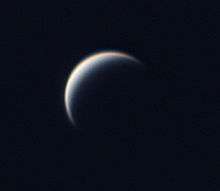Kosmos 482
| Mission type | Venus probe |
|---|---|
| Operator | Soviet Academy of Sciences |
| COSPAR ID | 1972-023A |
| SATCAT № | 05919 |
| Mission duration | Launch failure |
| Spacecraft properties | |
| Spacecraft type | 3V (V-72) no. 671 |
| Bus | 3MV |
| Launch mass | 1,180 kilograms (2,600 lb) |
| Start of mission | |
| Launch date | March 31, 1972, 04:02:00 UTC |
| Rocket | Proton 8K78M |
| Launch site | Baikonur 31/6 |
| End of mission | |
| Decay date | 05 May 1981 |
| Orbital parameters | |
| Reference system | Geocentric |
| Regime | Medium Earth |
| Perigee | 204 kilometres (127 mi) |
| Apogee | 9,806 kilometres (6,093 mi) |
| Inclination | 51.9305° |
| Period | 201.40 minutes |
Kosmos 482 (Russian: Космос 482 meaning Cosmos 482), launched March 31, 1972 at 04:02:33 UTC, was an attempted Venus probe which failed to escape low Earth orbit.
Beginning in 1962, the name Kosmos was given to Soviet spacecraft which remained in Earth orbit, regardless of whether that was their intended final destination. The designation of this mission as an intended planetary probe is based on evidence from Soviet and non-Soviet sources and historical documents. Typically Soviet planetary missions were initially put into an Earth parking orbit as a launch platform with a rocket engine and attached probe. The probes were then launched toward their targets with an engine burn with a duration of roughly 4 minutes. If the engine misfired or the burn was not completed, the probes would be left in Earth orbit and given a Kosmos designation.
Kosmos 482 was launched by a Molniya 8K78M booster on March 31, 1972, 4 days after the Venera 8 atmospheric probe and may have been similar in design and mission plan. After achieving an Earth parking orbit, the spacecraft made an apparent attempt to launch into a Venus transfer trajectory. It separated into four pieces, two of which remained in low Earth orbit and decayed within 48 hours into south New Zealand (known as the Ashburton balls incident), and two pieces (presumably the payload and detached engine unit) went into a higher 210 x 9800 km orbit. An incorrectly set timer caused the Blok L stage to cut off prematurely, preventing the probe from escaping Earth orbit.
At 1:00 AN on April 3, 1972, four red-hot 13.6 kg titanium alloy balls landed within a 16 km radius of each other just outside Ashburton, New Zealand.[1] The 38 cm-diameter spheres scorched holes in crops and made deep indentations in the soil, but no one was injured. A similarly shaped object was discovered near Eiffelton, New Zealand, in 1978.
Space law required that the space junk be returned to its national owner, but the Soviets denied knowledge or ownership of the satellite. Ownership therefore fell to the farmer upon whose property the satellite fell. Kosmos 482 was thoroughly analyzed by New Zealand scientists which determined that they were Soviet in origin because of manufacturing marks and the high-tech welding of the titanium. The scientists concluded that they were probably gas pressure vessels of a kind used in the launching rocket for a satellite or space vehicle and had decayed in the atmosphere.
See also
References
- ↑ "New light on mysterious space balls". New Zealand Herald. 2002-08-24. Retrieved 2006-10-08.
External links
- Space.com: Aussies, Kiwis Take Mir Deorbit in Stride 02:11 pm ET February 20, 2001
- Wired Magazine: Awaiting Mir's Crash Down Under 02:00 AM Feb, 19, 2001


